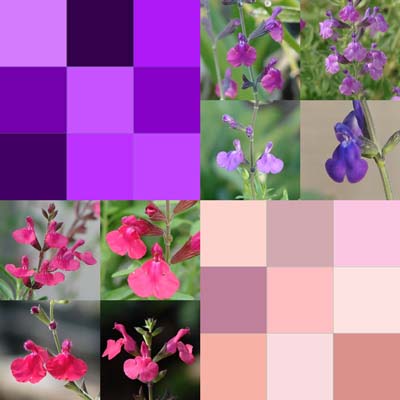Drought Praise: Hot Pink and Purple Autumn Bloomers

Late summer is a good time to plant at the coolest times of day. Settling in new Salvias before Indian summer gives their roots a chance for strong growth so they can withstand winter's chill and leaf out again next spring.
The pink and purple selections described here are part of the closely related Autumn Sage (Salvia greggii) and Mountain Sage (Salvia microphylla) groups that flower off and on from spring through summer, but particularly produce an abundance of blossoms in fall.
All are capable of withstanding winter cold as well as summer heat.
A Randy, Confusing Group
It's easy to get confused about which is which, when first encountering Autumn Sages and Mountain Sages. Until you look at their leaves, they may look like the same species due to the size, shape and distribution of their petite yet abundant flowers.
Autumn Sage has fine, smooth, elliptical leaves, whereas Mountain Sage has thicker foliage with larger, veined, ovate leaves. In contrast to Mountain Sage, which is dominated by red and pink flowers, Autumn Sage has a broader range of colors — reds, pinks, lavenders, oranges, purples, whites, and pale yellows.
Also, despite being native to different parts of Texas, the Southwest. and Mexico, Autumn Sage and Mountain Sage hybridize freely when they meet. They also cross with other sages they encounter.
However, until testing of plant DNA improves and becomes less costly, identification of accidental hybrids will continue to be based primarily on appearance and other observable plant characteristics, such as bloom season.
Nobody seems to know what crossed with Mountain Sage to create the more cold-tolerant Lemmon's Sage (Salvia lemmonii), which botanists John and Sara Lemmon discovered on their Southern Arizona honeymoon around 1881. You can read about the discovery in Getting Started: Salvias for the Southwest.
Sometimes gardeners make reasonable guesses about parentage when one species is growing close to another and a happy accident occurs. That was the case with Ultra Violet Hybrid Sage (Salvia lycioides x greggii 'Ultra Violet'), which garden writer and designer Lauren Springer Ogden discovered as a seedling in her Colorado garden.
Be forewarned: When you grow these Southwestern sages near each other, dalliances may happen.
Drought and Temperature Tolerances
Although S. greggii, S. microphylla, and their hybrids do a fine job of tolerating dry conditions, they benefit from supplemental watering. However, be careful not to overdo it, because their foliage may become lax and flowering may decrease.
The ability to bear up in full sun during hot weather is another characteristic of the group. However, a bit of shade during the hottest time of day is a good idea. Mountain Sage especially appreciates it.
Not all species in the Autumn Sage and Mountain Sage groups tolerate winter chill. Yet each plant described here has a strong history of roots surviving freezing temperatures. They die to ground following frost and then reemerge in spring.
Soil, Amendments, and Pollinators
Autumn and Mountain Sages seem to be adaptable to many kinds of soil. However, these are not plants that appreciate lots of fertilizer. Instead, one of the best soil amendments is grit or pea gravel to aerate the soil and improve drainage. This is essential in clay soils.
Adding a bunch of gravel to your soil can be tiring, but it's small payment for the wealth of bees, butterflies and hummingbirds these plants attract to gardens.
A Cheerful Bouquet of Color
Although the plants pictured here may look tasty to the human eye, deer generally dislike munching on sages. If you live in deer country, that's good news for sustaining this attractive garden bouquet of pinks and purples.
Pretty Pinks
Cold Hardy Pink Autumn Sage (Salvia greggii 'Cold Hardy Pink') Zones 5 to 9
- Creamy, hot-pink flowers with pale beelines
- Fragrant, mid-green foliage and reddish-green calyxes
- 24 inches tall and wide in bloom
- Full sun to partial shade
- Butterflies and hummingbirds
- Groundcover
Wild Thing Autumn Sage (S. greggii 'Wild Thing') Zones 6 to 10
- Coral pink flowers with deep pink throats
- Fragrant, deep green foliage with dark stems and calyxes
- 36 inches tall and 24 inches wide in bloom
- Full sun to partial shade
- Butterflies, honeybees and hummingbirds
- Groundcover and container plant
Wild Rose Lemmon's Sage (Salvia lemmonii 'Wild Rose') Zones 6 to 10
- Creamy crimson-pink flowers
- Fragrant, mid-green, veined foliage
- 48 inches tall and 36 inches wide in bloom
- Full sun to partial shade
- Honeybees and hummingbirds
- Border or accent
Pleasing Purples
Saint Isidro's Sage (Salvia lycioides x greggii 'San Isidro') Zones 6 to 9
- Lavender-blue flowers with pale throats
- Mid-green foliage and purple-green calyxes
- 24 inches tall and 18 inches wide in bloom
- Full sun
- Butterflies, honeybees and hummingbirds
- Groundcover
Ultra Violet Hybrid Sage (Salvia lycioides x greggii 'Ultra Violet') Zones 5 to 9
- Pinkish-purple flowers
- Mid-green foliage and dusky purple calyxes
- 24 inches tall and 18 inches wide in bloom
- Full sun
- Butterflies, honeybees and hummingbirds
- Groundcover and container plant
Suggestions and Questions
All of these sages are subshrubs, which means that they combine woodiness with soft herbaceous growth. In areas with moderate winter temperatures they may even remain evergreen year round. We recommend all for front-of-border planting. Many are efficient groundcovers and some work well in container gardens.
Need more information? Please call or email us, and we'll be glad to help you.

 Salvia lycioides x greggii 'San Isidro'
Salvia lycioides x greggii 'San Isidro'  Salvia greggii 'Black Cherry'
Salvia greggii 'Black Cherry'  Salvia greggii 'Wild Thing'
Salvia greggii 'Wild Thing'  Salvia greggii 'Cold Hardy Pink'
Salvia greggii 'Cold Hardy Pink'
Comments
There are no comments yet.